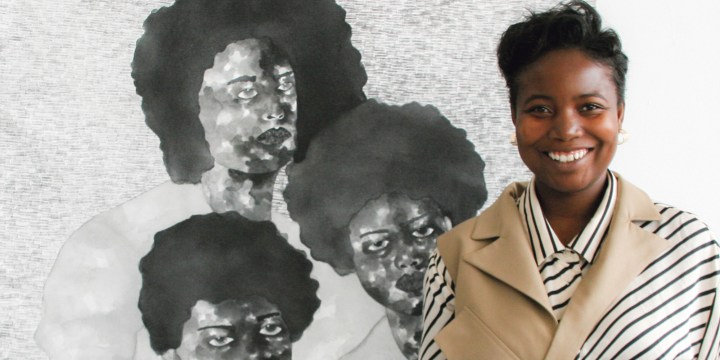Art
SA art scene rises to challenges of Covid, AI and sustainability

Buffeted by the winds of a changing world, designers and artists are finding new meaning and purpose. They explain how being able to adapt nimbly is what it takes to survive and thrive.
From changing technology to finding sustainability and surviving a global pandemic, South African artists and designers have had to adapt quickly. It’s a skill that is now a key ingredient of their success.
In Yann Martel’s Life of Pi, the author says that “all living things contain a measure of madness that moves them in strange, sometimes inexplicable ways. This madness can be saving; it is part and parcel of the ability to adapt. Without it, no species would survive.”
For the artist, having the ability to adapt is a survival skill. And after a few years of a shattering global pandemic, the creative world still seems to be facing major disruption: from the rise of AI to challenging economic conditions. We’ve asked a few artists for their thoughts on the future of their industry. The answers are a beacon of light in an otherwise darker sociopolitical time.
AI: embracing the technology
For artists practising in non-traditional mediums, such as digital art or animation, the rise of AI tools is shaping and changing their work dramatically. Artificial intelligence research labs such as Midjourney and OpenAI have systems that generate images from written prompts, which calls into question what the role of artists will be in the near future.
Lwazi Msipha, a South African animator, says he’s excited about AI even though it offers new challenges for artists and animators alike.
Msipha is listed on Forbes Africa’s 30 Under 30. He was winner of the Youth Achiever Award at the 2022 South African Film and Television Awards, and creator of My Cartoon Friend, which has featured on Cartoon Network.
“I love technological advancements, especially in the creative space,” he says. “I have dabbled in AI and I am still shocked at what it can do.”
AI can be a great tool to help artists and animators, says Msipha: “AI can help artists and animators automate tedious tasks, such as colouring and shading, which can save time and allow them to focus on more creative aspects of their work.”
However, he acknowledges that AI can also be a threat to artists, affecting their livelihoods and raising ethical concerns about plagiarism.
Msipha believes the future of AI and art depends on what artists make of it and how the industry adapts to its continued development. He is studying towards a master’s degree in animation and film-making at Gobelins, an animation school in Paris, and will graduate in June 2023.
He hopes to share the knowledge he gained there and “to grow the South African animation industry”.
Fashion: the future is sustainable
In the past few years, many fashion houses and retailers have started to shift to more sustainable ways of producing garments – sometimes just by greenwashing dubious practices, and sometimes successfully.
The team at Rewoven, founded in 2018 by Esethu Cenga, Tshepo Bhengu and Lonwabo Mgoduso, is “reimagining textile waste”. They explained in a 2021 article by Bubblegum Club: “We saw sustainable fashion, and recycling in particular, as a good opportunity to help with job creation and inequality in a way that fashion and development could work together.”
In November 2021 they hosted a new initiative, The Future of Fashion Indaba, in partnership with the Swedish Institute and the Swedish embassy in South Africa. According to the company’s website, the indaba is a non-profit initiative whose aim is to create a space for “collaborative learning” that can contribute to the creation of an African fashion industry that is not only successful financially but ethically as well.
The indaba did this by hosting masterclasses and lectures which seek to educate all participants in the local fashion industry and beyond on the “circularity and ethics” in the local fashion industry.

For Cape Town-based sustainable fashion brand Sage & Sunday, creating quality garments that contribute to a cleaner, greener Earth is an integral part of their business ethos. Photo: Sage & Sunday
Speaking of things to look out for, Jakob Slabbert, the founder and designer of Sage & Sunday, a local sustainable menswear brand, has noticed an increase in sustainable small businesses in the past three years since the establishment of his own brand.
“It’s very joyful to see businesses starting but also older businesses making sustainable fabrics,” he says.
Asked what he predicts for the future of the local sustainable fashion scene, Slabbert brings up hemp fabric.
“South Africa has the perfect climate to produce mass amounts of hemp. Hemp in general, compared to cotton, uses much less water, almost no pesticides and a lot less land to produce. It will be extremely beneficial for South Africa economically for us to produce hemp locally.”
In addition, “this is multifaceted job creation – from the planting of the hemp to the processing of the fibre to the making of the fabric and then the making of the garments”.
The only thing preventing this from happening is that the government has not yet created legislation to make it possible.
“The government still classifies hemp as a drug despite the difference between hemp and marijuana,” says Slabbert.
“Hemp has no chemical in it that produces any medicinal effect and is primarily used for the fibres it has to offer.”

For Cape Town-based sustainable fashion brand Sage & Sunday, creating quality garments that contribute to a cleaner, greener Earth is an integral part of their business ethos. Photo: Sage & Sunday
Another important factor in sustainability is equity, as well as fostering a healthy working environment. Many sustainable businesses are not only practising sustainability in their products but in their operations as well. For PICHULIK, which won the 2022 Twyg sustainability award for jewellery, this is at the core of its sustainable practices.
Katherine-Mary Pichulik, founder of the brand, explains that making intentional decisions from the beginning such as having local manufacturing and sources “from the get-go, even at the sacrifice of profit” is an important part of its sustainability practices.
Indeed, the brand embraces sustainability from a “human perspective” by offering everyone involved in the creation and maintenance of the brand the respect and money that is due.
This is done by paying crafters above-market remuneration, investing in its producers and supply chain, offering training and mentorship to its team, creating a healthy environment by giving priority to team members’ physical and mental health and fostering a working environment based on respect and understanding, says Pichulik.
In addition to their Twyg sustainability award, the brand launched collaborations with South Africa’s Lukhanyo Mdingi and Denmark’s Marlene Birger.
Pichulik says there is great potential for growth in bringing manufacturing back to South Africa.

Pichulik is a South African jewelry brand whose sustainable practices are based on taking ‘a humans perspective’ on business and design. Photo: Michael Oliver Love
“A few brands produce locally – however, many produce in India, China and Thailand. If we really had to commit to our local industry, the potential for job creation and skill development would be exponential.”
In 2023, PICHULIK plans to do more “interesting” international collaborations, as well as to introduce a new product category and home in on its French market.
Visual art: honing the craft
In the visual art world, which ranges from paintings to animation, the way in which art is being created is changing and so is its curation.
Johannesburg-based artist and designer Thabeng Lehobye, who uses charcoal as his main medium, works primarily in the realm of space – analysing different spaces (such as Johannesburg) and “the people that inhabit it and how they relate to the city”.
In an interview, he discusses how the pandemic created a different energy in the art space.
“Pre-Covid there was almost the sense of being in a rat race; then suddenly came the pandemic. It felt like, all of a sudden, we were stuck in these personal spaces that we were actually ignoring… For some reason, we had become so unfamiliar with ourselves and with our own spaces,” he says.
What was sparked then is something that he is still adding into his practice today: “I have never collaborated as much as I did during Covid. The technology obviously allowed for that and it almost made people more approachable.”
In 2021, Lehobye won first prize in the Thami Mnyele Fine Art Awards, one of the most prestigious art awards in the country. His work is on show at the Lizamore Gallery and Denzil’s and Jo in Johannesburg and at the Knysna Fine Art Gallery in the Western Cape.
Lerato Nkosi, a visual artist, fashion stylist and designer based in Johannesburg, says that with Covid-19 came a massive shift in her artistry. Where she had previously used vibrant colours and focused primarily on fashion art, she started using ink and stamps with a more monochromatic palette.

Karishma R Rajcomar’s award winning-photograph, Stare in agony, which won a 2022 Canon Picture Perfect award.
For Nkosi, the stains that ink leaves are symbolic of the complexities of relationships people have and the mark that is left when leaving those relationships behind.
Like Lehobye, she gave priority to collaborations and this year she won the inaugural ANNA Award, a partnership between a South African brand producing sustainable menstrual products and Latitudes, a digital gallery for contemporary South African and African art.
Durban-based photographer Karishma R Rajcomar was the recent winner of the 2022 Canon Picture Perfect competition. The picture that won, titled Stare in Agony, is an achingly beautiful portrait of a man looking straight into her camera. Rajcomar has found that receiving national and global attention offers great opportunities in an industry that is slowly becoming more accessible, despite the challenges posed by the pandemic.
She believes that being meticulous and creating images that are exceptional is the only way to compete in the photography world, where technology is advancing and creating an even more cut-throat environment for photographers. Now she is deep in the hustle and bustle of the festive season with her photography studio, Bright Spark Photos, while also finishing her book.
For Thamsanqa (Thami) Majela, the winner of the Standard Bank 2022 Young Artist Award for dance, the Covid-19 pandemic meant the artist had to adapt and perform outside of the usual stage while using modes of connection such as video to share his art.
Majela has previously worked in digital media, having made short films such as Sub Zero, Each Passing Minute and Layered Waves. During the pandemic, he worked on projects such as The Last Supper for Arts and Culture’s pandemic project at the University of Johannesburg, which “sought to highlight the plight of the homeless who could not ‘stay home, stay safe’ ”.
Heading into 2023, Majela plans to continue to hone his craft, both digitally and in person, through his performances. DM168
This story first appeared in our weekly DM168 newspaper which is available for R25 at Pick n Pay, Woolworths, SPAR and Exclusive Books. For your nearest stockist, please click here.


















Comments - Please login in order to comment.